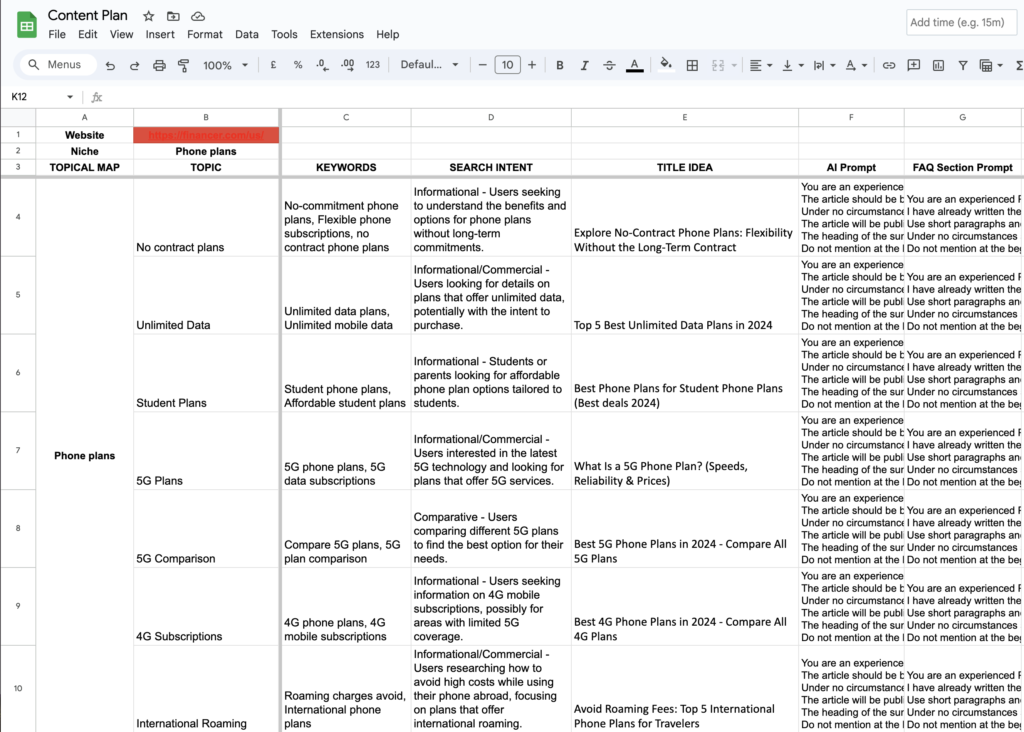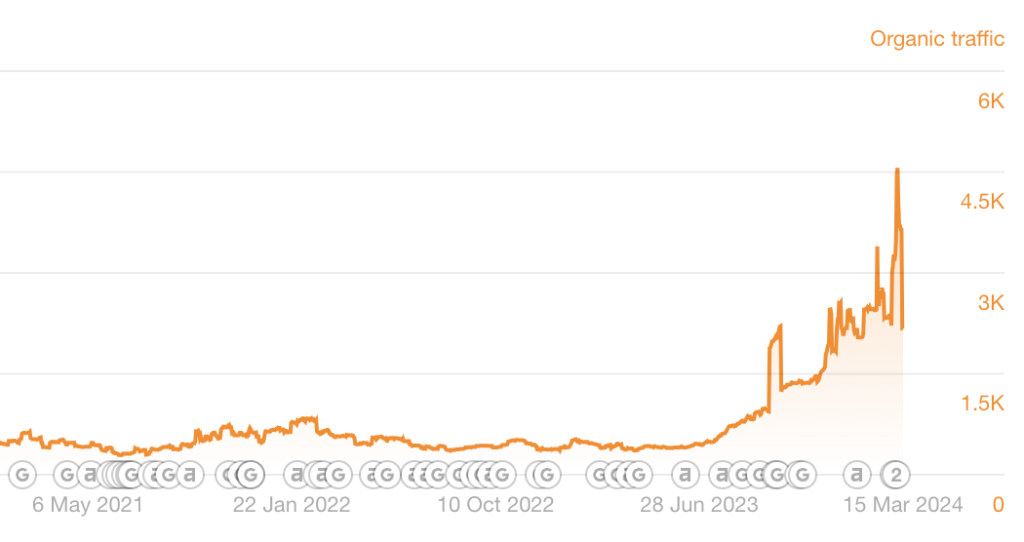In the fiercely competitive tech niche, standing out requires not just a presence, but authority and strategic insight.
Our client, an EU-based mobile phone plan comparison site, faced a significant challenge: despite being active for four years, they struggled to grow their organic traffic.
Our six-month project transformed their online visibility, resulting in a remarkable +427% increase in traffic and more than doubling the revenue from organic visits.
This case study outlines the strategic approach we took to achieve these results, focusing on building topical authority and optimizing site structure without the need for backlinks.
Objective
The primary goal was to boost the client’s website from a stagnant position to a leading authority in the mobile phone plan comparison space. This meant inproving the site’s organic traffic and, by extension, increasing revenue from organic visits.
As the clients primary focus previously was in email marketing and social media, they had not focused on optimizing their content for SEO. Changing this meant we first created a detailed content strategy that was focused on SEO, optimizing their site structure, and a focus on E-E-A-T (Expertise, Authority, Trust, and Experience).
Challenges
- Deprioritizing SEO: The client hadn’t focused on optimizing their site for SEO as they were mainly driving traffic to their offers through email and social media.
- Stagnant Organic Growth: Despite the site being live for four years, the site had very low organic traffic.
- Lack of Topical Authority: The site lacked the content focus to create enough topical authority to rank; their existing content was a mixed bag of news, articles and product reviews from many different sub-topics within their niche.
- Poor Site Structure and Navigation: The existing site structure was not clear and it was hard to navigate to their most important pages.
- Insufficient E-E-A-T: There was a lack of clear information about the company and the authors, undermining the site’s credibility and authority.
Strategy and Implementation
Content Strategy
We used Ahrefs Keyword Explorer to find relevant keywords and then using our Content Plan sheet to organize the topics, keywords and titles into an easy-to-follow content map. We also used that Content Plan to delegate keep track of each article’s status when it was handed over to the content team to write, edit, and publish. (If you want a free copy of my Content Plan sheet, send me a message).
Here’s an example how that Content Plan looks like.

You’ll notice that we also used some of the data collected in our keyword research to create dynamic prompts to do part of the writing with AI. The client’s content team did a lot of editing on the AI content before publishing based on the SEO guidelines we provided to their team.
This content strategy focused initially on one specific aspect of their niche, establishing a strong foundation of topical authority before expanding into other sub-topics. Over six months, we published over 100 new pieces of content, each researched and designed to match to the user’s search intent but also so that it fits into the internal linking plan and helps convert visitors to clients.
Site Structure and Navigation
We overhauled the site’s structure and navigation to improve user experience and crawlability.
By organizing content into content clusters and improving internal linking, we made it easier for both users and search engine crawlers to navigate the site, thereby boosting its visibility and rankings.
Originally, the client’s URL structure was set to the default WordPress permalink structure using the date in the URLs.
For example:
https://www.example.com/2021/03/21/sample-post/
This structure is not good for SEO. Including dates in URLs can reduce the relevance of content over time, making older posts seem outdated. If the URL of the post says “2021” it might signal to visitors the page has outdated information.
Instead of this date-based structure, we implemented a category based structure. This means that we used the main search term, for example “Compare phone plans” as the main folder in the URL and structure other topics as child pages. This helps group relevant terms together and also making the URLs much more readable.
The structure we chose is like this:
- Sub-topic 1
- Sub-topic 2
- Sub-topic 3
- Sub-topic 1
- Sub-topic 2
- Sub-topic 3
Topic 3
- Sub-topic 1
- Sub-topic 2
- Sub-topic 3
Focus on E-E-A-T
To address the lack of trust and authority, we implemented a strategy focused on E-E-A-T.
This included rebuilding the “About Us” and “Contact” pages with information about the company and the team behind the project. We also created structured data for the company contact information, founders, authors, as well as, added their review guidelines in the Schema markup using the publishingPrinciples markup.
Most of the posts on the client’s website had just the generic “Admin” marked as the author of the content. This was another thing that needed to change, and we made sure every author on the site had a clear expert author bio, contact information, and a profile photo.
By showcasing the expertise and credentials of the writers, we were able to significantly boost the site’s credibility and authority in the eyes of both users and search engines.
Results
The implementation of these strategies led to remarkable outcomes within just six months:
- Organic Traffic Growth: The site experienced a +427% increase in organic traffic, a testament to the effectiveness of the content strategy and SEO optimizations.
- Revenue Increase: Revenue from organic traffic more than doubled, highlighting the direct impact of increased traffic and improved site authority on financial performance.
- Sustained Growth: The client reported continued growth in traffic beyond the project’s conclusion, indicating the long-term sustainability of the strategies employed.

In Ahrefs – my favorite SEO tool – the organic traffic is shooting up like a rocket as well following the project.

The site is now also ranking for six times the amount of keywords it did before. The number of keywords in the top 1-3 places in Google shot up from just 8 to 67, however, I expect this to keep growing in the coming months even more.

Conclusion
This case study demonstrates the power of a well-crafted SEO strategy focused on content quality, site structure, and E-E-A-T in driving significant improvements in organic traffic and revenue. By prioritizing topical authority and user experience, we were able to achieve remarkable results for our client in a highly competitive niche, without relying on backlink building. The success of this project underscores the importance of a holistic approach to SEO, one that addresses the needs of both search engines and users.
Want to see results like this for your business?
Get in touch with us today or book your SEO audit below to get started.
I just need some feedback
I just need some feedback
Get quick, personalized feedback from an experienced professional who knows how to make good things even better. You can ask for feedback on a specific page or just ask to dig around the site to see what comes up.
- 15-min private video audit
- 100% personalized for your site
- Actionable SEO, UX & CRO recommendations
- High-definition video & audio
- Delivered within 3 days
After purchase, you’ll be directed to a form for audit details.
I need more help with my site
I need more help with my site
Get the SEO help you really need, when you need it, from a real expert… but better! I’m here to consult your team, fix your technical SEO issues, or review your on-page strategy. Just ask me for a quote.
- One-time consulting or monthly package
- Figure out why your site is not ranking
- Refine your on-page strategy to boost traffic and conversions
- 100% personalized – no automated low-value reports



